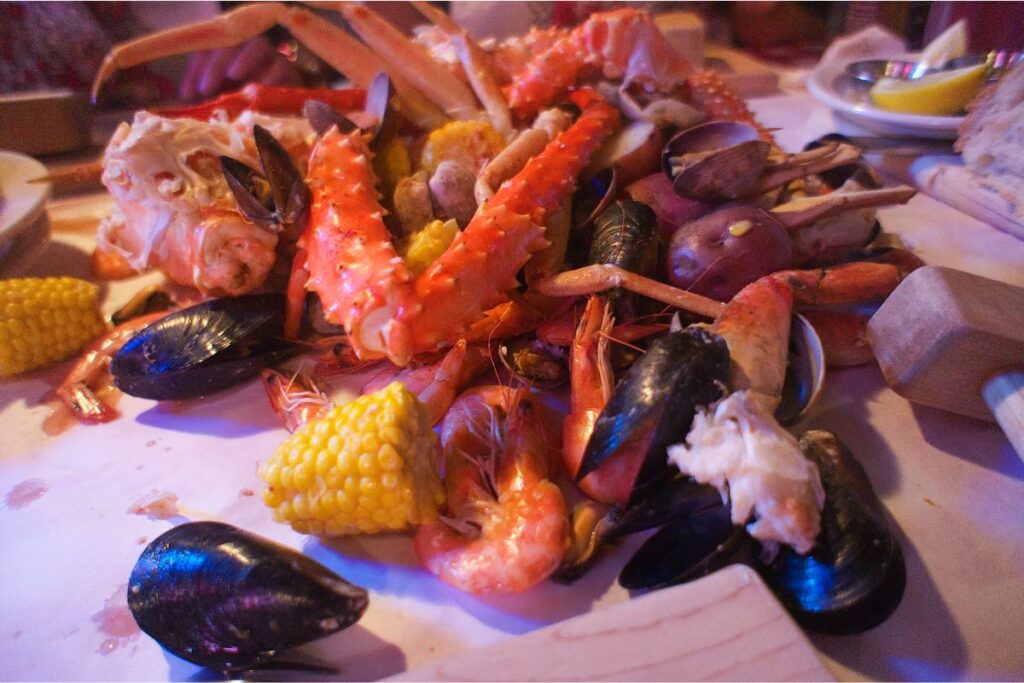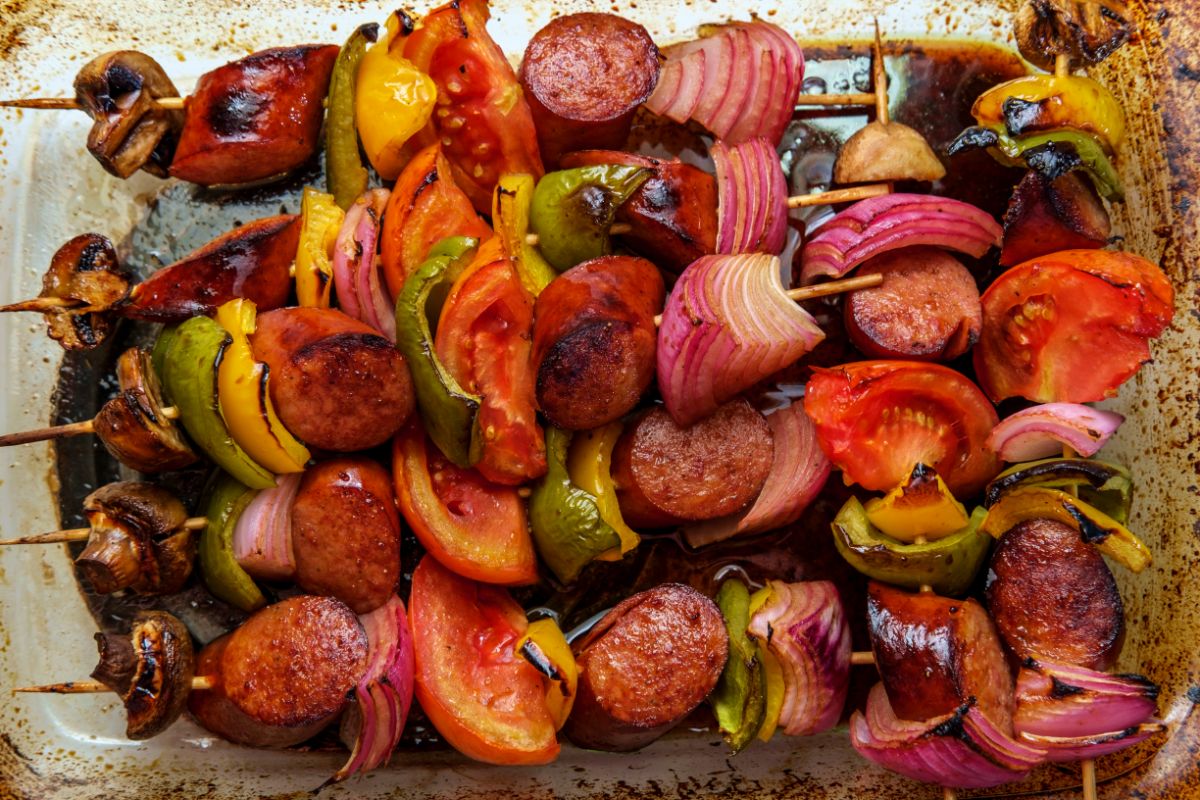Kielbasa, a culinary gem, has traversed borders and time, establishing itself as a staple in Polish cuisine and beyond. This article embarks on a savory journey into the world of traditional kielbasa cooking. It aims to uncover the traditional way to eat kielbasa, exploring its roots, varieties, and cooking methods that best capture its essence. As we delve into the traditions shaping kielbasa’s consumption and examine innovative approaches that continue to redefine it, we invite food lovers to discover how this beloved sausage can elevate meals from ordinary to extraordinary. Traditional kielbasa cooking does it all, offering a blend of culinary wisdom, historical insights, and health considerations to enhance your cooking game. Whether you’re a seasoned chef or a curious home cook, get ready to explore the rich tapestry of flavors and textures that kielbasa has to offer.
The Culinary Heritage of Traditional Kielbasa Cooking
Kielbasa, with its robust flavors and rich history, is at the core of traditional Kielbasa cooking. It’s not just food; it’s a culinary voyage through Polish heritage. This beloved sausage, known for its versatility and depth of flavor, invites us to explore a world where food intertwines with tradition and cultural identity, epitomizing the essence of traditional Kielbasa cooking.
Tracing the Roots of Kielbasa
Central to Polish cuisine, kielbasa stands as a testament to the nation’s enduring spirit and culinary innovation. Originating from the Slavic word “klobasa,” meaning meat sausage, kielbasa’s history is rich and flavorful. Its journey from humble beginnings to becoming a symbol of Polish culinary pride showcases the depth of traditional Kielbasa cooking. Kielbasa has not only witnessed Poland’s history but also become a significant part of it, representing more than just a dish—it’s a cherished slice of Polish heritage.
Kielbasa: More Than Just a Sausage – A Journey into Traditional Kielbasa Cooking
Indeed, pondering Polish cuisine without acknowledging kielbasa would be an oversight. Beyond its culinary delight, kielbasa embodies the resilience and joy of Polish people. Through feasts and family meals alike, it bridges generations. It narrates stories of past and present. It’s not merely consumed; it’s celebrated. Kielbasa fosters connections and reinforces the Polish culinary legacy.
As we unravel the mystery of enjoying this delicacy traditionally, we must recognize kielbasa’s significance. It’s more than sustenance. It’s a culinary icon that brings people together. It offers a taste of Poland’s rich cultural tapestry with every bite. So, let’s tighten our apron strings and embark on this gastronomic adventure. The journey through kielbasa’s history is just as enriching as the flavors it promises.
The History of Kielbasa: Roots in Traditional Kielbasa Cooking
Kielbasa has deep roots in the culinary traditions of Poland. Its story is intertwined with the nation’s history, making it more than a mere sausage. It’s a cultural icon that reflects the Polish people’s resilience and adaptability.
Kielbasa, a culinary gem, has traversed borders and time, becoming a staple in Polish cuisine and beyond. This article embarks on a savory journey to uncover the traditional ways to enjoy kielbasa. We’ll explore its roots, varieties, and the cooking methods that best capture its essence, alongside innovative approaches that continue to redefine it.
Kielbasa’s history is rich and multifaceted. It’s a testament to Polish culinary ingenuity. Moreover, it showcases the sausage’s ability to bring people together. Whether in Poland or abroad, kielbasa remains a beloved part of culinary traditions. Its history not only tells the story of a nation but also of a food that transcends borders.

Traditional Kielbasa Varieties
Kielbasa’s world is rich and diverse. I
From Humble Beginnings to Culinary Staple
The journey of kielbasa began centuries ago, originating as a practical method for preserving meat. Through the years, it transformed into a celebrated culinary staple across Poland, with each region developing its own version. This rich diversity of kielbasa reflects the evolving Polish society and cuisine over the centuries.
Kielbasa and Polish Celebrations
Kielbasa transcends mere food; it’s an integral part of Polish celebrations. Essential at weddings and festivals, its presence on the table symbolizes abundance and joy, highlighting its cultural significance. Kielbasa stands as a proud emblem of Polish hospitality and communal bonds.
The Global Journey of Kielbasa
With Polish migration, kielbasa ventured beyond its homeland, introducing its rich flavors worldwide. Today, kielbasa enjoys global popularity, skillfully adapting to local tastes while maintaining its Polish essence. This worldwide acceptance underscores kielbasa’s versatility and its universal appeal, making it a beloved sausage across cultures.
t spans various flavors and traditions that reflect Poland’s regional culinary landscapes. Each type offers a unique taste experience, inviting us to explore the depths of Polish sausage craftsmanship.
Fresh vs. Smoked Kielbasa
The first distinction in the realm of kielbasa comes between fresh and smoked varieties. Fresh kielbasa, known for its raw, juicy nature, requires cooking to unveil its flavors. It serves as a versatile base for numerous dishes. In contrast, smoked kielbasa, with its rich aroma and ready-to-eat quality, speaks of tradition and time-honored smoking techniques. This distinction marks a crucial choice for kielbasa enthusiasts, guiding their culinary adventures.
Pork, Chicken, and Beef Kielbasa
Traditionally, pork has been the primary meat in kielbasa, prized for its fat content and flavor affinity with spices. However, chicken and beef varieties have emerged, offering lighter or more robust alternatives. Chicken kielbasa caters to those seeking a leaner option, while beef kielbasa appeals to those desiring a more intense flavor profile. This diversity ensures that kielbasa remains accessible and enjoyable for a wide range of tastes and dietary preferences.
Exploring Regional Varieties
Delving into Poland’s regions unveils a kaleidoscope of kielbasa types, each with its signature flavor and preparation method. Kielbasa Lisiecka, from Lesser Poland, boasts a delicate balance of garlic and pepper. Meanwhile, Kielbasa Krakowska offers a coarser texture beloved by those who favor a heartier bite. These regional specialties not only enrich the kielbasa landscape but also celebrate the local ingredients and culinary traditions that shape their unique character.
Kielbasa’s variety is a testament to its integral role in Polish cuisine and culture. Whether fresh or smoked, pork, chicken, or beef, regional or widespread, each kielbasa variety invites us on a flavorful journey. It’s a journey through Poland’s culinary heritage, showcasing the artistry and diversity that make kielbasa a beloved sausage worldwide.
Cooking Kielbasa the Traditional Way
The art of cooking kielbasa is steeped in tradition, offering a window into the soul of Polish cuisine. Each method of preparation unveils unique flavors and textures, making kielbasa a versatile component of numerous dishes.check out these kielbasa recipes.
Boiling Kielbasa

Boiling is perhaps the simplest, yet profoundly traditional way to cook fresh kielbasa. This method gently coaxes out the sausage’s natural flavors, resulting in a tender and juicy delicacy. To enhance the taste, adding a bay leaf or garlic cloves to the boiling water is common. This method not only preserves the kielbasa’s inherent juiciness but also imbues it with subtle aromatic nuances.
Baking Kielbasa
Baking offers another avenue to explore the richness of kielbasa. Preheating the oven and placing the kielbasa on a baking sheet allows it to evenly brown, locking in flavors and creating a slightly crispy exterior. A popular twist involves adding a mustard and honey glaze midway through baking, introducing a sweet and tangy contrast to the sausage’s savory depth.
Grilling Kielbasa
Grilling kielbasa is synonymous with summer barbecues and outdoor gatherings. It imparts a smoky essence and a charred exterior that many find irresistible. The key is to grill over medium-high heat, turning the sausage frequently to achieve uniform grill marks. For those seeking perfection, allowing the kielbasa to sear undisturbed initially can create the coveted crispiness.
Sautéing and Pan-Frying Kielbasa
For a quick and flavorful meal, sautéing or pan-frying kielbasa is ideal. Cutting the sausage into half-inch slices and frying them in a bit of oil enhances their golden exterior while preserving the juicy interior. Incorporating onions and a splash of beer can elevate the dish, adding layers of flavor that complement the kielbasa beautifully.
These traditional cooking methods each bring out different aspects of kielbasa’s flavor and texture. Whether you prefer the moist tenderness from boiling, the sweet tanginess from baking, the smoky char from grilling, or the quick, savory bite from pan-frying, kielbasa’s versatility shines through. Experimenting with these techniques allows you to discover your favorite way to enjoy this cherished Polish sausage.
Traditional Accompaniments for Kielbasa
Kielbasa is more than just a sausage; it’s a culinary experience that’s elevated by its accompaniments. Traditional sides and condiments play a crucial role in bringing out the best in kielbasa, creating a harmonious meal that’s rich in flavors and textures.
Creamy Mashed Potatoes: A Classic Comfort
Creamy mashed potatoes are the quintessential side for kielbasa, providing a smooth and velvety contrast to the sausage’s robust flavors. The richness of the potatoes complements the smokiness of kielbasa, making every bite a delightful blend of comfort and taste. For an added layer of flavor, incorporating roasted garlic or a dollop of sour cream can transform this classic pairing into an irresistible dish.
Crisp Sauerkraut Salad: A Refreshing Side
The tanginess of crisp sauerkraut salad cuts through the richness of kielbasa, offering a refreshing crunch that balances the meal. Mixing sauerkraut with shredded carrots and apple slices not only adds a flavorful twist but also introduces a spectrum of textures and probiotic benefits. This side dish is a vibrant and nutritious complement to the hearty sausage.
Roasted Root Vegetables: Earthy and Sweet
Roasted root vegetables, such as carrots, parsnips, and beets, bring an earthy sweetness that pairs beautifully with kielbasa. Tossing the vegetables in olive oil, rosemary, and thyme before roasting enhances their natural flavors, resulting in a colorful and nutritious side that harmonizes with the main dish. The subtle sweetness of the vegetables contrasts with the savory notes of the sausage, creating a well-rounded meal.
Grilled Corn on the Cob: Smoky Sweetness
Grilled corn on the cob mirrors the smoky flavors of grilled kielbasa, making it an ideal accompaniment. Brushing the corn with butter and seasoning with salt and pepper before grilling elevates its natural sweetness, offering a satisfying balance to the smoky and savory sausage. This simple yet flavorful side adds a touch of summer to any kielbasa dish.
These traditional pairings for kielbasa not only enhance the meal but also pay homage to Polish culinary traditions. Whether opting for the classic comfort of mashed potatoes, the refreshing crunch of sauerkraut salad, the earthy sweetness of roasted root vegetables, or the smoky sweetness of grilled corn, these sides ensure a memorable dining experience that celebrates the rich flavors of kielbasa.
Navigating Common Queries in Cooking Kielbasa
Cooking kielbasa, deeply rooted in tradition, often raises several questions, especially for newcomers to this culinary delight. In this section, we tackle some common queries to enhance your experience with cooking and enjoying kielbasa.
FAQs on Cooking Kielbasa: Preparation and Enjoyment Tips
In the realm of traditional Kielbasa cooking, understanding the basics of storage, preparation, and cooking techniques is crucial. Here’s how to navigate these aspects effectively:
How Should You Store Kielbasa Before and After Cooking?
For optimal freshness in traditional Kielbasa cooking, store your kielbasa in the refrigerator prior to cooking. Should you have leftovers, it’s essential to wrap them tightly or place them in an airtight container and refrigerate for up to four days. For extended storage, freezing is your best option.
Can You Eat Kielbasa Without Cooking It?
In the context of traditional Kielbasa cooking, it’s important to note that smoked kielbasa, being precooked, can be eaten without further cooking. However, fresh kielbasa requires thorough cooking to ensure both safety and optimal flavor.
What Quick Kielbasa Recipes Work for Busy Evenings?
Kielbasa, a staple of traditional Kielbasa cooking, is perfect for quick, versatile meals. Consider stir-frying it with vegetables or adding browned slices to pasta for a speedy, satisfying dinner. Incorporating kielbasa with eggs offers a delightful, protein-rich breakfast-for-dinner option.
How Do You Know When Kielbasa Is Fully Cooked?
A key aspect of traditional Kielbasa cooking is ensuring the sausage is fully cooked. Fresh kielbasa should reach an internal temperature of 160°F (71°C). Precooked or smoked kielbasa only needs to be heated to about 140°F (60°C).
What Are Healthier Ways to Enjoy Kielbasa?
Traditional Kielbasa cooking also allows for healthier options. Choosing chicken or turkey kielbasa presents a leaner alternative. Pairing it with a variety of vegetables or whole grains can create a balanced and nutritious meal.
Addressing these common questions enhances the cooking and enjoyment of kielbasa, from storage tips to quick recipes and health considerations. These FAQs simplify the journey of traditional Kielbasa cooking, making it an enjoyable and straightforward process. Armed with these tips and insights, you’re ready to dive into the delicious world of kielbasa. Whether adhering to traditional methods or exploring modern twists, kielbasa’s versatility and rich flavor profile make it an exceptional ingredient that elevates any meal into a memorable culinary experience.
Conclusion: Embracing the Kielbasa Tradition
In wrapping up, this guide shines a light on both traditional and modern ways to enjoy kielbasa. It highlights the sausage’s versatility and its deep-rooted cultural heritage. With the insights on preparation, cooking methods, and perfect pairings, you’re well-prepared. Now, you can introduce the authentic taste of kielbasa into your culinary creations.
The Journey Ahead
Whether you choose to honor its Polish origins or blend it into contemporary dishes, kielbasa offers a flavorful adventure. It’s a journey that promises to enrich your cooking experience. So, embrace the opportunity to explore the myriad flavors of kielbasa. Happy cooking!

